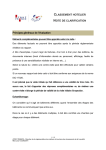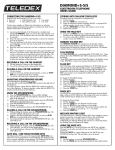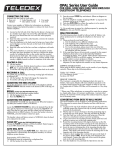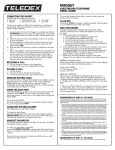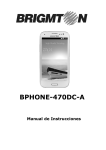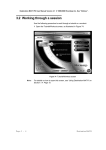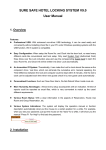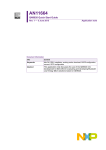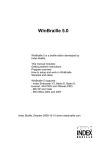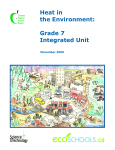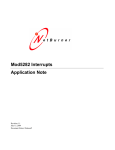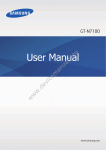Download HES Trainer Manual: Annex 1
Transcript
Analysis on Energy Use by European Hotels 2/42 ENERGY EFFICIENCY AND RENEWABLE ENERGY APPLICATIONS IN THE HOTEL SECTOR Analysis on Energy Use by European Hotels 3/42 Legal Disclaimer The sole responsibility for the content of this publication lies with the authors (the Hotel Energy Solutions official partners). It does not necessarily reflect the opinion of the European Union. Neither the EACI nor the European Commission are responsible for any use that may be made of the information contained therein. Please cite this publication as Hotel Energy Solutions (2011), Energy Efficiency and Renewable Energy Applications in the Hotel Sector, Hotel Energy Solutions project publications First edition: 2010 Revised version, July 2011 Copyright notice © Hotel Energy Solutions (2011) Reproduction is authorised, provided the source is acknowledged, save where otherwise stated. You may copy, download or print Hotel Energy Solutions (HES) content for your own use and you can include excerpts from Hotel Energy Solutions (HES) publications, website and multimedia products in your own documents, presentations, blogs, websites and teaching materials, provided that the suitable acknowledgment of Hotel Energy Solutions as source and copyright owner is given. Where prior permission must be obtained for the reproduction or use of textual and multimedia information (sound, images, software, etc.) such permission shall cancel the abovementioned general permission and clearly indicate any restrictions on use. All requests for public or commercial use and translation rights should be submitted to icr-‐[email protected]. Hotel Energy Solutions (HES) Project Basics Full name: Excellence in Energy for the Tourism Industry – Accommodation sector: SME hotels (EETI) Contract N°: IEE/07/468/S12.499390 Hotel Energy Official Partners Project Supported by EE and RE Applications in the Hotel Sector 1/71 TABLE OF ANNEXES ANNEX I. 2 HES E-‐TOOLKIT USER’S MANUAL. 1.01 QUESTIONNAIRE 1.02 REPORTS ENERGY RELATED REPORT ENERGY SOLUTIONS REPORT CARBON FOOTPRINT REPORT 1.03 RETURN ON INVESTMENT CALCULATOR DATA ENTRY SCREEN ENERGY SAVINGS REPORT CASH FLOW RETURN ON INVESTMENT OUTPUTS 2 9 9 12 15 16 16 19 20 22 EE and RE Applications in the Hotel Sector 1/22 ANNEX I. HES E -‐ TOOLKIT USER’S MANUA L. The web toolkit can be accessed at the following URL: http://hes.e-‐benchmarking.org/index.html As the user, you would then press “It’s free, get started”, which will open a screen requesting login and password. First-‐time users must register in order to create an account. This is necessary to utilise the e-‐toolkit. Once registered, you can enter login and password to connect to the e-‐toolkit. The platform will request verification of your account information. Inside the e-‐toolkit platform, you will see a “+ project” option in the menu that allows you to create a new project. It is useful to note that you can have several projects stored simultaneously, with the information saved in your online account. To consult other projects, go to the “My projects” tab that is located on the main menu. 1.01 Q UESTIONNAIRE To start working with the e-‐toolkit system, you will need to complete a questionnaire that gathers information about your hotel that is needed to evaluate a project. The questionnaire is divided in the following six steps: Step 1: General information In this section, you will need to define the name of the project, the year of reference, and the country where the project is based. The system will automatically fill out the survey completion date. To continue to the next section and store the entered information, press the “Save and continue” button. EE and RE Applications in the Hotel Sector 2/22 Step 2: Hotel type, occupancy & staff This section asks for information about your hotel, such as the hotel type (e.g. hostel, motel, resort hotel, inn, etc.), the average occupancy in a given period, the number of guest nights sold during the last year, and the number of full time staff in the same period. EE and RE Applications in the Hotel Sector 3/22 Step 3: Hotel Description: This section asks about: - Features of the building, such as: year of construction, year of last major refurbishment, main type of building construction, current occupation of building, construction system of the building (structure, walls, and roof); - Geographical area: whether the hotel is located in a coastal, mountain, rural, or urban area; - Climatic conditions: approximate number of months in which outside temperature exceeds 30°C, and the approximate number of months in which outside temperature is bellows 10°C; - Hotel size and facilities (total floor area, area of guest rooms, number of beds, etc); - Type of package offered: whether the hotel offers full board, half board, self-‐catering, etc; - Hotel star rating (5 stars, 4 stars, 3 starts, etc.); - Other guest facilities: whether the hotel has a restaurant, lounge & bar, laundry, and so on; - Air conditioning: whether the hotel uses an air conditioning system. EE and RE Applications in the Hotel Sector 4/22 Step 4: Energy consumption This section gathers information on energy consumption by type of energy, such as: electricity (and its use – whether for lighting, water heating, etc.), coal, district heating, liquefied petroleum gas, natural gas, heavy oil, light wood chips or pellets. For every option selected, the system displays additional questions on the amount of energy used, and the units used to measure that energy (e.g. KWh, m3, etc.). EE and RE Applications in the Hotel Sector 5/22 You can obtain information about the hotel’s electricity consumption from your electricity bills. These show the consumption during certain periods of time (in KWh) – see chapter 4.4 of the training manual for more information on how to read your hotel’s electricity bills. To compile the information requested, you will need to have available electricity bills from the last 12 months, and sum the total electricity consumption for each period (normally in KWh). The total electricity consumption will be requested in the “Amount of total electricity consumed” box. The user will be requested to indicate the type of use of this electricity, e.g. it could be that the hotel has an air conditioning system that is powered with electricity, or that the heating system requires electricity to run. The same procedure has to be followed with the other energy sources or fuels. Step 5: Renewable Energy This section gathers information about existing renewable energy systems that the hotel has in place. The window is divided in two parts, the first being a list of different renewable energy technologies. If you select a technology, the system will ask questions regarding the installed capacity of the technology selected, the amount of renewable energy generated, and the units used (e.g. KWh). The second part aims to identify the natural resource potential and the space available space at the hotel for installing new renewable energy technologies. These considerations include: access to a river, enough water flow in the river, enough area to install a hot water tank, and/or enough space to place a wind turbine. If the hotel has surrounding ground area, you will be requested to specify the size of the area around the hotel. The following table provides recommendations on where to obtain some of this information: Access rights to a nearby stream or river This information can normally be obtained from the local authorities or regulatory entity. Contact your local authorities to see what rules apply. Water flow of the river Local or state governments, or national entities, are normally in charge of monitoring river water levels and flows, and other characteristics of the river. Un-‐shaded space on which to site solar panels This information can be gathered with a simple visual analysis of the surrounding area of the facilities, identifying areas where sunlight is not blocked e.g. by trees, neighbouring buildings, large equipment and so on. Unobstructed flow of wind to install a This information can be gathered through building-‐mounted wind turbine or a mast-‐ simple analysis of the surrounding area of the mounted wind turbine facilities, identifying e.g. neighbouring buildings, mountains, and large trees that obstruct wind flow. EE and RE Applications in the Hotel Sector 6/22 Information related to the area and space available inside the hotel may be obtained from the hotel’s architectural plans. If you don’t have these, you will need to measure the area of the available space (width, length and height). EE and RE Applications in the Hotel Sector 7/22 Step 6. Outcomes This section will compile information about the energy measures that are already implemented in your hotel, including relevant characteristics of your hotel’s insulation, lighting system, energy efficiency equipment, heat production system, boiler, temperature controls, space cooling systems, information for guests and staff, and any future plans for major refurbishment. EE and RE Applications in the Hotel Sector 8/22 This information can be obtained from a visual inspection of the hotel, by reviewing relevant files and archives related to implemented measures, or from equipment manufacturing manuals. (If you don’t have the equipment manuals, you can usually obtain the same information from the Internet or by contacting the manufacturer.) 1.02 R EPORTS Once the questionnaire has been completed, the e-‐toolkit automatically performs calculations to produce three reports: - Energy-‐related report - Energy solutions - Carbon footprint E NERGY RELATED REPORT The energy-‐related report provides information on the hotel’s current energy performance, and compares this with a predefined benchmark. The HES benchmark has been set based on review and analysis of data available on energy use by hotels in Europe. This analysis indicates that for most hotels, energy use falls in the range EE and RE Applications in the Hotel Sector 9/22 200-‐400 kWh/m2/yr. This is consistent with the main range of energy performance differentiation in published energy benchmarks (e.g. by Accor, Nordic Swan scheme, LowE project, WWF/IBLF, or the Thermie programme), which is also between 200-‐400 kWh/m2/yr. A statistical meta-‐analysis combining data from available studies indicates that average energy use by hotels is in the range of 305-‐330 kWh/m2/yr. The data indicates large variations in energy use levels. Overall, it is evident that the variation between the hotels within each sample is far greater than the differences between the averages for different samples. There is no evidence that there are any statistically significant differences in levels of energy use intensity (kWh/m2/yr) between hotels or other accommodation with different star ratings. The analysis also indicates that kWh/m2/yr is a more widely reported and useful comparative measure of energy use levels than kWh/guest-‐night, as the latter measure is susceptible to large variations due to changes in hotel occupancy levels in different years as well as variations in room sizes between different grades of hotel, although it is useful for managers when considering business performance. There was insufficient data to derive benchmark values for kWh/guest-‐night (and given the variations to which this measure is subject, benchmarks for this measure would be of limited comparative value in any case). The HES benchmark has been set based on quintiles of the data from the meta-‐analysis referred to above, and are as follows: Range kWh/m2/year Quintiles Excellent < 195 kWh/m2/year 195 20% Good 195 -‐ 280 kWh/m2/year 280 40% Average 280 -‐ 355 kWh/m2/year 355 60% Poor 355 -‐ 450 kWh/m2/year 450 80% Very poor > 450 kWh/m2/year >450 The e-‐toolkit Energy Report shows and benchmarks energy use intensity (measured in kWh/m2/yr) for each hotel. It also shows, but does not benchmark, both kWh/guest-‐night and kWh/guestroom/year, as these are useful measures for managers when considering business performance. Other points to note are that overall energy use levels can be relatively constant except in the most extreme climatic zones, since reduced need for heating is balanced by increased use of air conditioning. Although increases in energy for heating and less for cooling (and vice-‐versa) balance out over quite a wide climatic range, there will be significant differences in the necessary technologies to reduce energy use in different climatic zones. EE and RE Applications in the Hotel Sector 10/22 The Energy related report provides a rating bar that indicates the evaluation of the hotel’s energy performance (KWh per m2 per year). In this window, there is also a box with different energy performance metrics, including energy performance per m2 year, energy performance per guest night, and energy performance per guest room per year. These figures can be useful as the baseline to compare with future improvements in the hotel. EE and RE Applications in the Hotel Sector 11/22 E NERGY S OLUTIONS R EPORT The purpose of the Energy Solutions Report is to provide suggestions for energy efficiency and renewable energy technologies that may be suited to the characteristics of your hotel, taking into account those technologies that the hotel is already using. For example, the Energy Solutions Report takes into account the solar radiation at the geographical location of the hotel. The e-‐toolkit has information of the levels of solar radiation experienced in different EU countries, an important factor when providing recommendations on the use of solar renewable energy technologies. The system groups EU countries in three different categories according to whether they experience high, moderate, and low levels of solar radiation. These groupings are based on data for solar radiation mapped across Europe. Table: data for solar radiation mapped across Europe. Highest solar radiation Moderate solar radiation Lower solar radiation Bulgaria Austria Belgium Cyprus France Czech Republic Greece Hungary Denmark Italy Slovakia Estonia Malta Slovenia Finland Portugal Germany Romania Ireland Spain Latvia Lithuania Luxembourg Netherlands Poland Sweden United Kingdom Note: There are variations in solar radiation levels within countries, but these are only significant for France and Germany. However, in the e-‐toolkit system, it has not been possible to sub-‐divide these countries according to solar radiation levels. EE and RE Applications in the Hotel Sector 12/22 The report shows general recommendations for improvements in a table that classifies them according to whether they require no investments, small investment, or high investment. For every recommendation, there is a small description of the technology or improvement recommended. EE and RE Applications in the Hotel Sector 13/22 The technologies include: Energy Efficiency Energy saving light bulbs Lighting controls – occupancy-‐linked controls Regulation of space heating and cooling Air conditioning and ventilation Cogeneration and trigeneration Window and Building insulation Potential savings through bioclimatic design Electric appliances with high-‐energy efficient rating Renewable Energy Solar thermal – solar hot water heating systems PV electricity power system Biomass boilers Geothermal heat pump (ground source heat pumps) Micro-‐hydropower energy systems Wind energy – small scale wind turbines Behavioural change Staff engagement Guest engagement EE and RE Applications in the Hotel Sector 14/22 C ARBON FOOTPRINT REPO RT The objective of this report is to provide information on the carbon emissions that are associated with the hotel’s electricity consumption, fossil fuels consumption, biomass consumption and renewable energy use. The calculator uses the information provided in the questionnaire to perform these calculations. The carbon emissions are displayed in Kg of CO2 on an annual basis. It is important to note that the calculation of CO2 emissions due to electricity consumption takes into consideration the national emissions per KWh of electricity produced. The CO2/KWh rate can vary widely from country to country, and it is calculated according to the energy mix and fuel types that are used for generating electricity in that particular location. The CO2 emissions derived from fossil fuels are calculated from the information provided in the questionnaire on the amount of fuel used, and the type of fuel. EE and RE Applications in the Hotel Sector 15/22 1.03 R ETURN ON I NVESTM ENT C ALCULATOR The return on investment calculator helps the hotelier decide whether it is financially worthwhile to invest in an EE or RE technology project. The calculator will give you an estimate of different financial metrics. To start working with the ROI calculator, select the option “Return on Investment Calculator” located on the left side of the menu screen. D ATA ENTRY SCREEN The first window introduces information that will be needed to perform the calculations, and the questions are divided in three sections: - Energy project type - Debt information - Financial information Energy project type This section displays a list of the EE and RE technologies that could be implemented in a hotel facility. For every technology selected (by clicking on the corresponding box), the system will display the following six questions. Please note that not all of them are mandatory: Total Investment* Annual Maintenance and Operation cost (EUR/year) Investment that the technology will require. This value is NOT affected by the inflation rate. This value will be applied during the whole cash flow period and it is affected by the inflation rate. There is no absolute standard as to which cost are included in Operation and Maintenance cost. Potential Annual Energy Savings This information varies from country to country and from (KWh/year)* technology to technology. Feed in Tariff (EUR/KWh) Other subsidy or incentives (EUR/KWh) Incentives that encourage the implementation of EE/RETs, If there is an energy price incentive. Predominant energy displaced* Indicate the type of energy that it is displaced due to the EE/RET implemented. Select “1” for electricity and “2” for Thermal energy. * Mandatory information required to perform the calculations. The distributor, manufacturer or project developer can provide all this information. EE and RE Applications in the Hotel Sector 16/22 Debt information The second section requests information on any existing debt financing for the project, including: Debt amount Amount to be financed Interest rate Cost of the financing Debt repayment period Number of years to repay the debt Please note that this information is not mandatory for performing the calculations. If the information is left blank, the system will assume that there is no debt financing for the project (only equity from the hotelier). Financial information The third part of this section requests information needed to calculate the metrics. Analysis Term (years)* Discount rate* Inflation TAX Rate Depreciation Period (years) is the amount of time or the period that the analysis covers. The minimum value is 1 year and the maximum analysis period is 20 years. The entry has to be whole number, not years with decimals. Is the rate used for computing present values, which reflects the fact that the value of money depends on the time in which the cash flow occurs. The raise in price level expected. The inflation affects the energy savings (income) and the operational costs. The rate applied to taxable income The amount of time required for the original capital investment to be fully recovered. It is used for accounting purposes and Tax deductions. The entry could be between 0 (Zero) and 20 years. And it is calculated in a linear regression diminishing the value of the total investment by a fixed amount each year. It is assumed that the final value (salvage value) at the end of the depreciation period is zero. Information on electricity prices, and fuel prices can be obtain from the energy bills, or an estimate (for different countries in Europe) can be obtained in the next URL address http://www.energy.eu/ Average Price of Electricity (EUR/KWh)* Average Price of Thermal energy (EUR/KWh)* * Mandatory information required to perform the calculations Once you have entered the information and pressed the “save and continue” button at the bottom of the window, the system will perform the calculations to evaluate the ROI metrics. Please note that given the amount of parameters taken into account in the calculation, it takes around 45 seconds to make the calculation and generate the reports. EE and RE Applications in the Hotel Sector 17/22 Reports By selecting the “Return on Investment Calculator” report you will be directed to the Energy Savings report window. In the upper right side of this window there are three icons. These icons represent the different ROI reports that the system generates, including: - Energy savings - Cash flow - Return on Investment outputs Reports EE and RE Applications in the Hotel Sector 18/22 E NERGY S AVINGS R EPORT The Energy Savings Report is divided into three tables. The first four tables summarise the information that was introduced in the data entry section for each type of technology (one table each for energy efficiency, renewable energy or other investments). Each row contains information about the energy price, total investment, maintenance and operating cost, and potential annual energy savings associated with a specific technology option for your hotel. The EE and RE investment tables are shown below: The ‘Other Investments’ is shown below: The total “Potential Annual Energy savings” is estimated from different factors, such as amount of energy saved, price of energy, feed-‐in tariff (if any) and/or other incentives. The fourth table adds together the total potential energy savings from the previous variables (total investment, annual operation cost, and potential energy savings) EE and RE Applications in the Hotel Sector 19/22 C ASH FLOW This report summarises information on the income, the breakdown of the costs, and the balance of each year of the analysis term of the project. The information is divided in two main sections: a summary table of the general project investment conditions, the cash flow. The first table is a summary of the project general conditions. The second table, “Cashflow of the complete project, is divided in two sections. The first section shows the investments (at the beginning of the project): The second section shows the energy savings (revenues) and the breakdown of costs (maintenance and operation costs, depreciation, interest, etc.) for each year: EE and RE Applications in the Hotel Sector 20/22 The amortization debt line shows an estimate of the gradual elimination of the debt in regular payments over a specified period of time. Such payments must be sufficient to cover both principal and interest. The depreciation line shows how the technology assets lose its value over time (in other words, they depreciate). The tool calculates the depreciation in equal instalments until the book value of the asset is reduced to zero. The second section also shows the balances for each year (net income after taxes). These values are then discounted to obtain their present value (PV). The NPV is the sum of the PV of a selected year plus the PV of all previous years. For example, the NPV of year 3 is the sum of the PVyear 3 + PVyear 2 + PVyear 1 + PVyear 0): NPVyear 3 = -‐3133.99 -‐3402.55 -‐3693.64 -‐10000 NPVyear 3 = -‐20230.18 The Internal Rate of Return (IRR) calculation is a unique value for the entire project, and it is displayed in the last year of the project’s analysis term. For example, if the project term is 10 years, the IRR will be shown in the column of year 10. The higher a project's internal rate of return, the more desirable it is to undertake the project. An investment is financially viable if the IRR exceeds the required “discount rate”. Otherwise, the investment should not be made. The discounted Payback Period is the period of time required for the return on an investment to "repay" the sum of the original investment, and the value will be displayed in the column of the year that matches the result of this calculation. Note: you can find more information about how to calculate the IRR, NPV and Discounted Payback period in Annex 8 of this training manual. EE and RE Applications in the Hotel Sector 21/22 R ETURN ON I NVESTM ENT O UTPUTS This report summarises all the metrics that were calculated to evaluate the project investment. The report has three tables. The first table displays information on how the investment has been financed (including debt and equity portion), the second table displays the metrics (IRR, Net Present Value and Payback Pack period in years), and the third table shows the same values in a leveraged scenario. IRR – Internal Rate of Return: The higher a project's internal rate of return, the more desirable it is to undertake the project. An investment is viable if the IRR exceeds the required “discount rate” and should be rejected otherwise. NPV – Net Present Value: Projects with a positive NPV represent net savings for the hotel. Projects associated with an NPV of zero will recuperate only the cost of the capital required to make the investment. Projects with a negative NPV represent a financial loss for the hotel. Discounted Payback Period: This is the period of time required for the return on an investment to "repay" the sum of the original investment. A short payback period is desirable, because the sooner the cash is recovered, the sooner it becomes available for reinvestment in other projects. Please note: in order for an investment to be attractive, the NPV must be bigger than zero, and the IRR must be bigger than the discount rate. When you have two project options with similar NPV or IRR, it is better to choose the project that has the shorter payback period. EE and RE Applications in the Hotel Sector 22/22 EE and RE Applications in the Hotel Sector 23/22






























